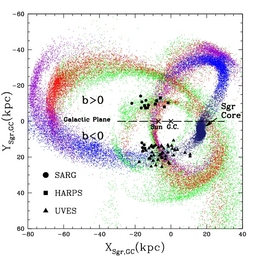SARG-TNG high resolution spectra help reconstructing the star formation history of the halo of our Galaxy
(results highlighted in the 464-1, Mar II 2007, issue of Astronomy & Astrophysics.)
Accretion from dwarf satellite galaxies is one potential
origin of the stellar halo of our galaxy, but the remnant cores of these
galaxies have both ages and metallicity distributions that do not match
those of the bulk of the halo population. Stars that have already been
stripped from the outer regions of those galaxies might however have
significantly different properties. This paper looks at the stars in the
Sagittarius dwarf elliptical. It finds that these stars are poorer in
metals, and suggests that additional observations might find stars to
match the properties of the galactic halo.
(L. Monaco et al., "High-resolution spectroscopy of RGB stars in the Sagittarius streams. I. Radial velocities and chemical abundances " Astronomy & Astrophysics, vol. 464, p. 201, 2007)


